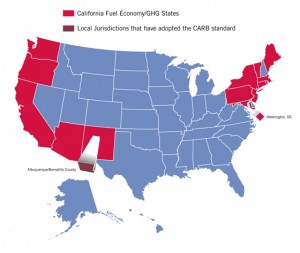
More than 40% of U.S. vehicle sales are affected by the proposed CARB regulation of greenhouse gases.
Hypocrisy in government is growing as fast as the budget deficit and unemployment lines. The proposal by the California Air Resources Board (CARB) and 13 — mostly eastern –states, and the District of Columbia to establish their own fuel economy and greenhouse gas programs continues to be controversial for its fragmenting of Environmental Protection Agency fuel economy regulations.
The 2005 CARB proposal was ultimately rejected by the Bush Administration last year. It is currently under review by the EPA at the request of the Obama Administration, which was elected in part because of the support of environmental pressure groups. EPA must grant a waiver for the CARB proposal to proceed and another ruling is due by April. All told, these states comprise more than 40% of the vehicles sold in the U.S. It is not even clear that any environmental benefit will accrue from such individual state actions. And no credible cost-benefit analysis exists.
Critics maintain that the CARB proposal creates regulatory and marketplace chaos with its confusing, and different standards, which are then followed by other states to varying inconsistent degrees. Without a doubt it is an administrative nightmare.
Virtually all major auto automakers oppose the regulation and have previously undertaken legal actions to prevent it. Lawmakers are trying to get promises from Chrysler and General Motors to drop opposition to the CARB proposal as part of the loan guarantees that are pending.
Worse, is the exemption in California, and presumably the “me too” states of cars bought by the ultra-wealthy. This “let them eat cake attitude” dictates what you can buy in these states and forces smaller vehicles on the road, while luxury cars and limousines continue for those who can afford them.
“If you look at it closely, the CARB scheme just doesn’t make sense,” says John McEleney, chairman of the National Automobile Dealers Association. “CARB’s regulation exempts any manufacturer that sells less than 60,000 vehicles in California on average for three years. This leaves a large swath of the industry unregulated and would even let Hummer off the hook if it were sold and operated as an independent company.”
Under this perverse aspect of the CARB proposal it looks like the following brands will be exempt: Audi, Bentley, Ferrari, Hyundai, Isuzu, Jaguar, Kia, Land Rover, Maserati, Suzuki, and possibly other high-end luxury brands including Mercedes-Benz. If Saturn, or Hummer, or Volvo, or Saab are bought by a company currently selling fewer than 60,000 vehicles in California, they would be exempt as well.
Why is this complicated regulation needed?
Back in 2007, the U. S. Congress passed the Energy Independence and Security Act (EISA), a law that increased the Corporate Average Fuel Economy standard (CAFE) by 40%, to at least 35 mpg by 2020. This new national EPA standard — it’s estimated — will decrease GHG tailpipe emissions by 30% by 2020. Of course if the population grows significantly and/or miles driven go up, the estimate changes downward.
Since carbon dioxide, one of the greenhouse gases, is directly proportional to fuel economy in an internal combustion engine using a carbon-based fuel, increasing fuel economy is the only way to significantly decrease greenhouse gas (GHG) emissions from motor vehicles. CO2 comprises 97% of vehicle GHGs. California wants greenhouse gas emission limits from vehicles that differ in their effect from EPA’s fuel economy regulations. Different doesn’t mean better. And it’s time to make sure that all people are treated equally.

The cost of multiple standard for cars sold in the US would be tremendous and further hurt the profitability of the domestic car companies. Green house gases are proportional to carbon fuel burned, higher mileage cars cars have a smaller GHG footprint. One of the falacies in the government’s approach is forcing the manufactures to produce higher mileage cars. We should be using our legislative mechanisms to stimulate customer demand for higher fuel economy vehicles. If you look today you will find rows of Toyota Prius sitting in dealer’s lots. Why? Very few people want them at $1.60 per gallon gas. At $4.00 gas, the lines were out the door.
We need to put a larger Federal tax on gasoline and consumers will want those high milage cars. It is not a question of can these cars be built. The question is what will make people buy them. We need to influence demand, not production.
Bob Austin
Another irony of the CARB proposal is that it is an attempt to go back to the old, failed CAFE standard that NHTSA has abandoned because it didn’t take into account vehicle safety effects. Average fuel economy applied across all vehicles led makers to undertake a drastic downsizing post 1975. Ultimately consumers rejected downsizing in part by going to trucks, a class of vehicles that had less stringent average fuel economy standards. Injuries and fatalities increased as cars got smaller and trucks got bigger. This was well documented by scientific research.
So NHTSA has now changed to a vehicle attribute methodology that separates fuel economy and safety and takes both into account. Fuel economy regulations are now indexed to the size of the vehicle. Makers are subject to different averages depending on the product mix. The California regulation reinstates the older, failed CAFE methodology since vehicles of all sizes are held to the same fuel economy standard. If enacted massive downsizing or restriction of sales to small cars will result. Since it takes approximately 15 years to replace the existing vehicle fleet, smaller cars, albeit with expensive advanced safety technology, will have accidents with much larger vehicles. Safety will surely suffer if the past data are valid – The National Academy of Scientists has studied this extensively. I have no doubt this will be the case.